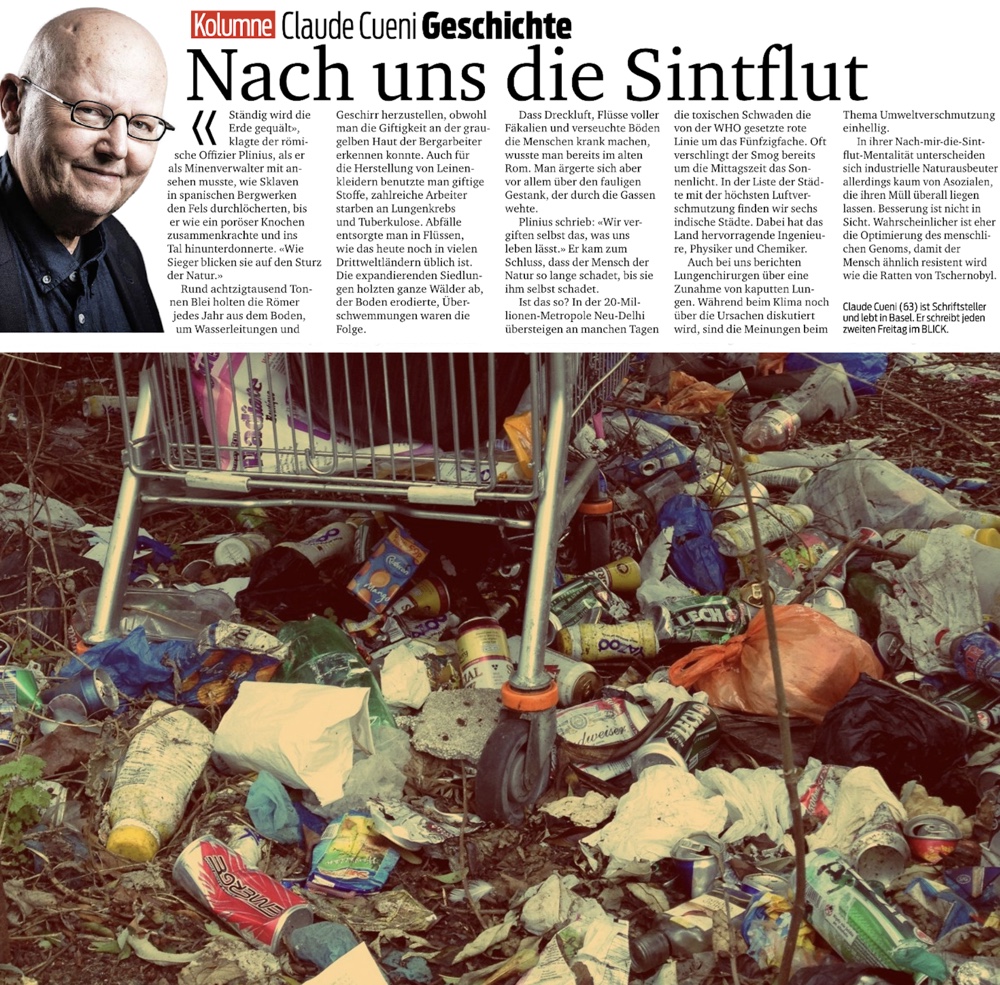Claude Cueni about the destruction of the environment
Translation: Adrian McDonalds
“is Constantly tormented of the earth,” said the Roman officer Pliny, as he had to watch as a mine Manager, as slaves in Spanish mines, the Rock is perforated, until it crashed like a porous bone and down to the valley thundered. “As the winner, you can look to the fall of nature.”
Around eighty thousand tons of lead picked up by the Romans every year, from the ground to water pipes and kitchenware, although you could detect the toxicity of yellow-grey skin of the miners. Also for the manufacture of linen dresses you used toxic substances, many of the workers died of lung cancer and tuberculosis. Waste disposed of in rivers, how is that even today in many third world countries. The expanding settlements they cleared all the forests, the eroded soil, Floods were the result.
the stench in the streets
That dirty air, rivers full of feces and contaminated soil make people sick, and then we knew already in ancient Rome. You got annoyed, but mostly about the putrid stench that wafted through the alleys.
Pliny wrote: “We are poisoning yourself what makes us live.” He came to the conclusion that the human nature is detrimental for so long, until it hurt him.
this Is so? In the 20-million metropolis of New Delhi, the toxic exceed on some days steam the of the WHO set the red line to the fifty-fold. Often the Smog engulfs the lunch time, the sun’s light. In the list of the cities with the highest air pollution, we find six Indian cities. However, the country has excellent engineers, physicists, and chemists.
nature exploiters and anti-social
Also in lung surgeons report an increase in the number of broken lungs. While the climate is still about the causes will be discussed, the opinions on the subject of environmental pollution are unanimous.
In their After-me-the-deluge mentality of different industrial natural exploiters of anti-social, leave their garbage everywhere. Improvement is not in sight. More likely, the optimization of the human genome is more likely, so that man is similarly resistant as the rats of Chernobyl.
Nach uns die Sintflut
«Ständig wird die Erde gequält», klagte der römische Offizier Plinius, als er als Minenverwalter mitansehen musste, wie Sklaven in spanischen Bergwerken den Fels durchlöcherten, bis er wie ein poröser Knochen zusammenkrachte und ins Tal hinunter donnerte. «Wie Sieger blicken sie auf den Sturz der Natur.»
Rund achtzigtausend Tonnen Blei holten die Römer jedes Jahr aus dem Boden, um Wasserleitungen und Geschirr herzustellen, obwohl man die Giftigkeit an der graugelben Haut der Bergarbeiter erkennen konnte. Auch für die Herstellung von Leinenkleidern benutzte man giftige Stoffe, zahlreiche Arbeiter starben an Lungenkrebs und Tuberkulose. Abfälle entsorgte man in Flüssen, wie das heute noch in vielen Drittweltländern üblich ist. Die expandierenden Siedlungen holzten ganze Wälder ab, der Boden erodierte, Überschwemmungen waren die Folge.
Dass Dreckluft, Flüsse voller Fäkalien und verseuchte Böden die Menschen krank machen, wusste man bereits im alten Rom. Man ärgerte sich aber vor allem über den fauligen Gestank, der durch die Gassen wehte.
Plinius schrieb: «Wir vergiften selbst das, was uns leben lässt.» Er kam zum Schluss, dass der Mensch der Natur so lange schadet, bis sie ihm selbst schadet.
Ist das so? In der 20-Millionen-Metropole Neu-Delhi übersteigen an manchen Tagen die toxischen Schwaden die von der WHO gesetzte rote Linie um das Fünfzigfache. Oft verschlingt der Smog bereits um die Mittagszeit das Sonnenlicht. In der Liste der Städte mit der höchsten Luftverschmutzung finden wir sechs indische Städte. Dabei hat das Land hervorragende Ingenieure, Physiker und Chemiker.
Auch bei uns berichten Lungenchirurgen über eine Zunahme von kaputten Lungen. Während beim Klima noch über die Ursachen diskutiert wird, sind die Meinungen beim Thema Umweltverschmutzung einhellig.
In ihrer Nach-mir-die-Sintflut-Mentalität unterscheiden sich industrielle Naturausbeuter allerdings kaum von Asozialen, die ihren Müll überall liegen lassen. Besserung ist nicht in Sicht. Wahrscheinlicher ist eher die Optimierung des menschlichen Genoms, damit der Mensch ähnlich resistent wird wie die Ratten von Tschernobyl.
© Blick, Folge 38 vom 14. Juni 2019
